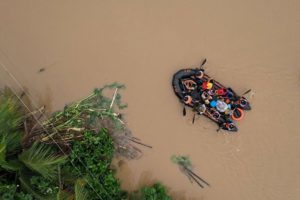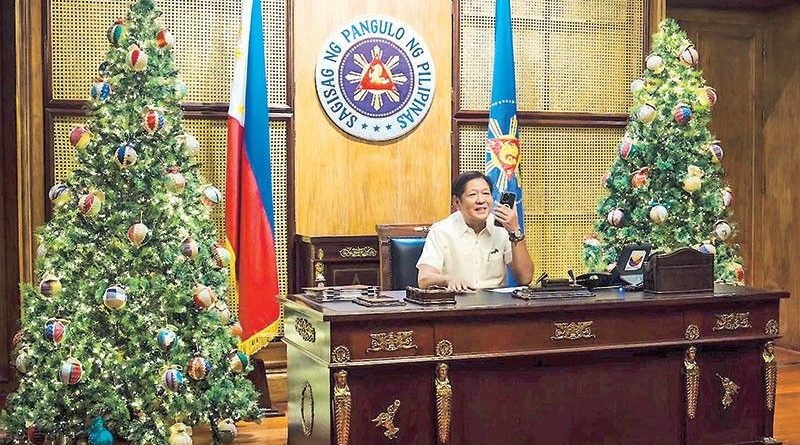ASEANEWS-TRUMP | MANILA: Marcos, Trump discuss alliance in phone call
WATCH VIDEO: https://www.youtube.com/watch?v=mxBsGPa8CXs
Photo shows President Marcos congratulating Donald Trump in his first phone call with the US president-elect yesterday. In his post, Marcos said ‘the overwhelming support of Filipinos in the United States on your triumphant win is a testament to the deep and enduring friendship between our nations.’/ Image from Instagram
US president-elect asks Marcos: How’s Imelda?
 MANILA, Philippines — President Marcos said he and US president-elect Donald Trump discussed their countries’ alliance and their desire to further strengthen the relationship in a phone call yesterday.Marcos told reporters the call with Trump was “very friendly” and “very productive,” and said he planned to see Trump as soon as he could.
MANILA, Philippines — President Marcos said he and US president-elect Donald Trump discussed their countries’ alliance and their desire to further strengthen the relationship in a phone call yesterday.Marcos told reporters the call with Trump was “very friendly” and “very productive,” and said he planned to see Trump as soon as he could.
“I think president-elect Trump was happy to hear from the Philippines,” said Marcos, whose two-year-old administration has strengthened Manila’s defense relationship with Washington as both countries face common security challenges in the region.
“We continued to talk about the relations – the alliance between the United States and the Philippines. And I expressed to him our continuing desire to strengthen that relationship between our two countries, which is a relationship that is as deep as can possibly be because it has been for a very long time,” Marcos told reporters in Catanduanes where he inspected areas hit by Super Typhoon Pepito and distributed assistance to affected communities.
He also recalled telling Trump of the “overwhelming” support Filipino-Americans gave him during the recent US elections.

“So, I’m sure he will remember that when we meet…and I plan to meet him as soon as I can,” Marcos said.
Marcos followed up his remarks with a Facebook post showing a photo of himself sitting at a desk between two Christmas trees and speaking into his smartphone.
The Chief Executive has sought to rebuild ties that frayed under his predecessor, Rodrigo Duterte, who was openly hostile to the US.
Last year, he made the first official visit by a Philippine leader to the US in more than 10 years.
Marcos is the son of the late strongman Ferdinand and former first lady Imelda Marcos, whom Washington helped flee into exile in Hawaii during the 1986 “people power” uprising.

ds by:
‘How’s Imelda?’
 He said Trump had asked about his 95-year-old mother. “He asked, ‘How is Imelda?’ I told him she’s congratulating you,” he said.
He said Trump had asked about his 95-year-old mother. “He asked, ‘How is Imelda?’ I told him she’s congratulating you,” he said.
The Philippines, a former US colony, is seen as central to Washington’s efforts to counter China’s increasingly assertive policies in the South China Sea and towards Taiwan.
Also yesterday, US Defense Secretary Lloyd Austin visited the Armed Forces of the Philippines’ Western Command in Palawan, where he reiterated Washington’s commitment to the Philippines under their 1951 Mutual Defense Treaty.
“Americans are profoundly committed to the defense of the Philippines,” Austin said at a joint press conference with his Manila counterpart Gilbert Teodoro.
“I can’t imagine a day that the United States of America and the Philippines aren’t closely allied,” Teodoro said.
Austin, meanwhile, reiterated his nation’s “ironclad commitment” to its Mutual Defense Treaty with the Philippines. “Let me say again that the Mutual Defense Treaty applies to armed attacks on either of our own armed forces, aircraft or public vessels, including our coast guards, anywhere in the South China Sea,” Austin said.
The US official said he also visited the Antonio Bautista Air Base in Palawan, one of the nine Enhanced Defense Cooperation Agreement (EDCA) sites in the country.
Teodoro said yesterday’s activity wrapped up Austin’s two-day visit to the country, with the latter engaging in discussions with WESCOM Commander Rear Admiral Alfonso Torres Jr. and personally witnessing “specific bilateral activities” between Philippine and US soldiers in Palawan.
DND spokesman Director Arsenio Andolong said that in their earlier engagement, President Marcos, Teodoro, and Austin “celebrated the remarkable strides the United States and the Philippines have made to expand and modernize the alliance and reinforced their shared vision for a free and open Indo-Pacific.”

ads by:
$1 million Pepito aid

Earlier, Austin announced the US commitment to support the Philippines’ response to Super Typhoon Pepito’s devastation, including $1 million in additional humanitarian assistance from the US Agency for International Development (USAID).
Andolong said the leaders discussed defense cooperation activities as well as regional security concerns and highlighted the need for deeper coordination to address challenges in the South China Sea, specifically acts of provocation by the Chinese.
At Camp Aguinaldo, Austin and Teodoro signed a General Security of Military Information Agreement (GSOMIA), which aims to enhance information sharing and deepen interoperability.
Andolong said the two defense chiefs also led the groundbreaking ceremony for a new bilateral Combined Coordination Center (CCC).
Andolong said Austin and Teodoro also visited a bilateral C2 Fusion Center – one of several built by US Indo-Pacific Command in the Philippines to enhance information sharing.
The two officials observed a demonstration of a T-12 Unmanned Surface Vessel, one of several unmanned aircraft that the US provided to the Philippine Navy through Foreign Military Financing.
Chinese naval and coast guard ships had repeatedly harassed Philippine vessels in the West Philippine Sea, using water cannons and powerful lasers or engaging the smaller Filipino boats in dangerous maneuvers.
Their frequent encounters at sea have turned the strategic waterway into a potential flashpoint between Washington and Beijing.
China claims sovereignty over almost the entire South China Sea, a conduit for more than $3 trillion in annual ship-borne commerce, putting it at odds with its Southeast Asian neighbors.
In 2016 the Permanent Court of Arbitration in The Hague ruled that China’s claims had no legal basis, siding with the Philippines which brought the case.
China rejects that ruling, but Washington, which supports it, says that decision is binding. Several other countries including Japan, Australia, Canada and those belonging to the European Union have voiced support for the arbitral ruling. — Michael Punongbayan


 Memento Maxima Digital Marketing
Memento Maxima Digital Marketing Ads by:
Ads by:







